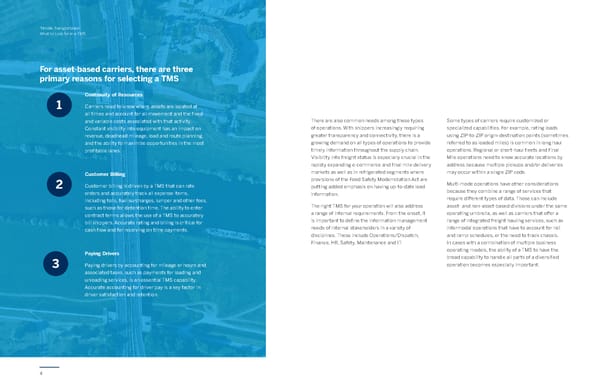4 Trimble Transportation What to Look for in a TMS There are also common needs among these types of operations. With shippers increasingly requiring greater transparency and connectivity, there is a growing demand on all types of operations to provide timely information throughout the supply chain. Visibility into freight status is especially crucial in the rapidly expanding e-commerce and final mile delivery markets as well as in refrigerated segments where provisions of the Food Safety Modernization Act are putting added emphasis on having up-to-date load information. The right TMS for your operation will also address a range of internal requirements. From the onset, it is important to define the information management needs of internal stakeholders in a variety of disciplines. These include Operations/Dispatch, Finance, HR, Safety, Maintenance and IT. Some types of carriers require customized or specialized capabilities. For example, rating loads using ZIP-to-ZIP origin-destination points (sometimes referred to as loaded miles) is common in long haul operations. Regional or short-haul fleets and Final Mile operations need to know accurate locations by address because multiple pickups and/or deliveries may occur within a single ZIP code. Multi-mode operations have other considerations because they combine a range of services that require different types of data. Those can include asset- and non-asset-based divisions under the same operating umbrella, as well as carriers that offer a range of integrated freight hauling services, such as intermodal operations that have to account for rail and ramp schedules, or the need to track chassis. In cases with a combination of multiple business operating models, the ability of a TMS to have the broad capability to handle all parts of a diversified operation becomes especially important. For asset-based carriers, there are three primary reasons for selecting a TMS Continuity of Resources Carriers need to know where assets are located at all times and account for all movement and the fixed and variable costs associated with that activity. Constant visibility into equipment has an impact on revenue, deadhead mileage, load and route planning, and the ability to maximize opportunities in the most profitable lanes. Paying Drivers Paying drivers by accounting for mileage or hours and associated tasks, such as payments for loading and unloading services, is an essential TMS capability. Accurate accounting for driver pay is a key factor in driver satisfaction and retention. Customer Billing Customer billing is driven by a TMS that can rate orders and accurately track all expense items, including tolls, fuel surcharges, lumper and other fees, such as those for detention time. The ability to enter contract terms allows the use of a TMS to accurately bill shippers. Accurate rating and billing is critical for cash flow and for receiving on time payments. 2 1 3 Trimble Transportation What to Look for in a TMS
 What to Look for in a TMS Page 3 Page 5
What to Look for in a TMS Page 3 Page 5